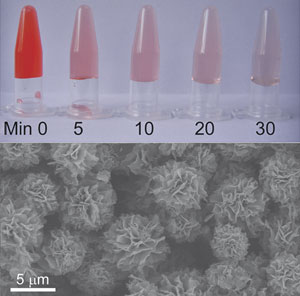Chinese scientists reveal an easy and effective synthetic method to obtain iron oxide microspheres to treat contaminated water.
Industrial wastewater containing toxic metal ions and organic pollutants has become a serious threat to the environment and public health. So the synthesis of three-dimensional micro and nanomaterials with the capability of absorbing undesired water contaminants in a straightforward and effective manner is a priority for environmental scientists.
Now Hongjie Zhang and colleagues at Changhun Institute of Applied Chemistry, have designed an easy method to synthesise flower-shaped Fe3O4 microspheres with magnetic properties, which can be used as absorbents to treat wastewater. Unlike previous synthetic routes, Zhang's hydrothermal method avoids the use of surfactants and copolymers that would need to be removed from solution.

Polluntants (red) are absorbed from solution by the iron oxide microspheres
|
The microsized metal oxide particles posses large surface areas which give them the capability of treating large volumes of water in short times. They can be easily separated from solution by a magnet and cleaned by heating to keep the same adsorption performance in subsequent use.
'In Zhang's work, the shapes of the iron oxide materials can be readily controlled, providing a series of materials to study the effect of shape on water treatment' says Wei-Guo Song, an expert in nanomaterials at the Chinese Academy of Sciences in Beijing.
'Most importantly, the materials can be recovered by combustion, and the removal capability is almost retained,' says Zhang. 'We are trying our best to use these new hierarchical materials in practical applications,'
Lorena Tomas Laudo
Enjoy this story? Spread the word using the 'tools' menu on the left or add a comment to the Chemistry World blog.




